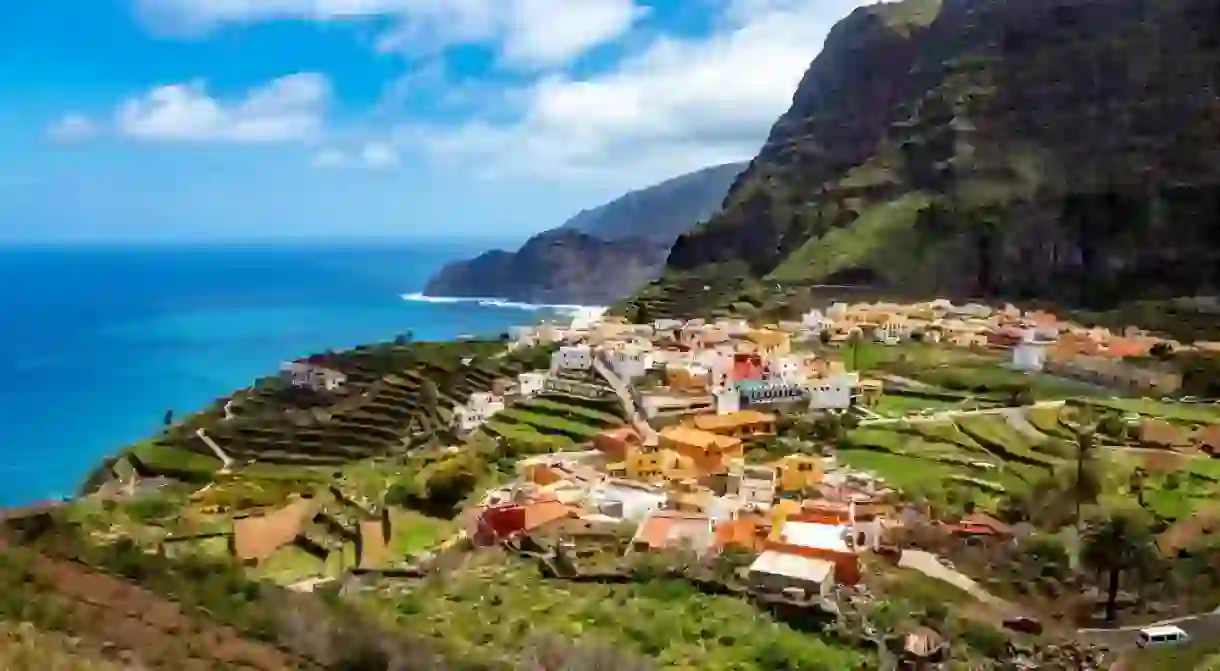The 10 Best Things to Do in La Gomera, Spain

The second smallest of the seven main Canary Islands, La Gomera is also one of the wildest and most untouched. Nature is at the heart of this green and beautiful isle, with whale- and dolphin-watching opportunities beyond its black beaches and trails criss-crossing volcanic mountains and the ancient forest of Garajonay National Park. Here’s our pick of the best things to see and do in La Gomera.
Hike up Alto de Garajonay
Natural Feature

With its black cliffs, deep ravines and jagged peaks, La Gomera isn’t short on scenic hiking routes. It’s also easily explored on foot, with marked trails of varying difficulty all across the island. One of the best routes – if you’re up for a challenge – is the 10.5km (7mi) hike from Pajarito junction to Hermigua, via the highest point on the island, the 1,487m (4,879ft) Alto de Garajonay.
Visit the black-sand Playa de Santiago
Natural Feature
What La Gomera lacks in powder-soft sands, it makes up for with the spectacle of its black- and grey-coloured volcanic beaches, with Playa de Santiago being one of the prettiest. The painted houses of the fishing village contrast against the dark shingle beach while hills loom behind. It’s located in Alajeró, on the south end of the island, and forms a bouncing-off point for excursions such as diving, snorkelling and kayaking.
Taste La Gomera wine
Building

The volcanic soil and abundant sunshine make conditions on the Canary Islands ideal for winemaking. La Gomera produces mostly white wines, with 80 percent of its vines being the forastera (Forastera Gomera) variety, exclusive to the island. Local produce is served in restaurants all around the isle, but for a more in-depth tasting experience, head to the Juego de Bolas Visitor Centre on Fridays, when 19 bodegas take turns presenting their wine (reserve in advance).
Take in the view from Mirador de Abrante
Natural Feature
Walk on air 620m (2,034ft) above the sea, on a 7m-long (23ft) glass walkway named the Mirador de Abrante (viewpoint of Abrante). On a cliff at the north end of the island, the overhanging viewing platform has glass walls, so it’s perfectly safe to linger here and absorb the view of Agulo village, the ocean and Tenerife beyond. A stop here is an ideal detour on trips to the scenic town of Hermigua.
Go dolphin and whale watching
Building

Marine life is abundant in these Atlantic waters – dolphins, pilot whales, sperm whales, Bryde’s whales and even sea turtles can all be spotted off La Gomera’s shores. Whale-watching tours by Excursiones Tina depart from Playa de Santiago or Vueltas. The three-hour version includes a swim in the bay, tapas and sangria, while the four-hour tour offers a private beach experience, with grilled tuna and barracuda that you can help reel in yourself.
Hear the local whistled language
Natural Feature
Due to living on an island with an undulating landscape and few roads, innovative islanders of long ago developed a unique form of communication: a whistled form of Castilian Spanish, which could reach people 5km (3mi) away. The technique is called Silbo Gomero, and it’s undergoing a revival, being taught to children once again. Waiters and taxi drivers might be kind enough to give you a rendition, or you can hear recordings and read about it at the PEG Los Telares, the Ethnographic Park of La Gomera.
Get to know Christopher Columbus
Historical Landmark

Italian explorer Christopher Columbus stayed in San Sebastián de la Gomera, the capital of the island, before setting off on his voyage to the Americas; La Gomera’s nickname is La Isla Columbiana, in homage to this history. Follow in his footsteps by visiting Casa de Colón, a house on the site where Columbus supposedly spent the night. Its small museum features pottery by the South American Chimú tribes, representing the kind of culture Columbus would have encountered in the New World.
Walk in the forests of Garajonay National Park
Natural Feature
Moss-covered laurel trees, rickety steps and drifting mist create an enchanting atmosphere in the prehistoric forests of Garajonay National Park. It covers 11 percent of La Gomera, its network of flowing streams serving as the main water source for the island. An easy but beautiful trail is the Cañada de Jorge, a 3km (2mi) loop starting in Valle Gran Rey. Due to climate change, ancient European rainforests such as these are now only found in the Canaries, Madeira and the Azores.
Walk through the valley to Roque Cano
Natural Feature

Shaped like a giant spearhead, the summit of Roque Cano is visible from many places on the island. You’ll need ropes and a harness to reach the top, but plenty of walks will take you close, allowing you to admire it from below. Set off on the trail from the village of Vallehermoso, or Beautiful Valley, past banana plantations and vineyards, and ascend 549m (1,800ft) before heading back down – it’s about 12km (8mi).
See an incredible rock formation by boat
Natural Feature
As the name suggests, the natural rock formation of Los Órganos resembles giant church organ pipes. Made by the slow cooling of basalt magma, it stands 80m (262ft) tall and 175m (574ft) wide – although its actual height is 800m (2,625ft), with most of it hidden underwater. You can only see it from the sea, thanks to its position on a cliff face along the north shore. Speedy Gomera offers tours aboard a speedboat several times a week.













